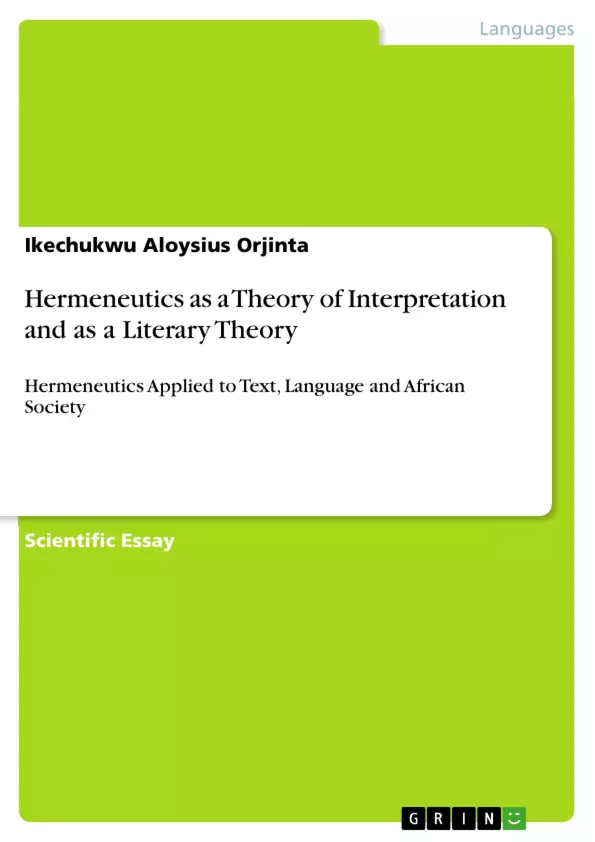Theories of language, linguistic and non linguistic communication are diverse. In the Humanities there are so many interpretative tools. These tools are means to an end and not the end in themselves. Just as we have equations in the natural sciences so do we have theoretical frameworks, literary criticisms and approaches to literature and the communication arts in the Humanities. These interpretative tools are keys to opening and analyzing works in the Humanities and other disciplines. Most of these theories are borrowed from other disciplines other than the ones exploiting them. In the literary sciences, rooms are given for inter-textual interpretations as well as for interdisciplinary and multidisciplinary approaches. Hence one could analyze a given fiction, drama or poem using one or more approaches as the case may be. At the primary and secondary school level, essays are simply written and novels are simply read and interpreted by simple minds. But at the tertiary educational level, one would expect the reader, the critic or the recipient to be thorough, analytical and scientific in his appraisal of the text before him. In receptions-theory the analytical mind is not left empty handed in this art of researching on or beyond the text .For one to access these tools effectively one must be equipped with literary terms. Interpretative tools are legion. Some are text-centered and linguistic and others are extra-textual and non linguistic. Hermeneutics and the sister theoretical frameworks like the positivism, formalism, explication de texte, New Criticism, Structuralism, post-structuralism, Semiotics, de-construction etc are text-centered interpretative tools while the society based theories like Marxist-socialism, psycho-analytic theory, feminism, receptions-theory, racial theory, cultural and intercultural studies, Literature and the media, literature and history, literature and biography etc fall under the beyond textual interpretative approaches. Our interest in this exercise is on the raw textual analytic approach. Many students usually prefer the easier approaches which are mostly society based and abhor the dry and puritanist approaches. This paper is aimed at introducing the audience to the rigors of scientific approaches to the study of texts, images and languages.
Table of Contents
- Introduction
- Hermeneutics
- Theory of Interpretation
- Hermeneutics in the Humanities and Literary Sciences
- Case-Study and Application (New Criticism)
- General Application Of The Theory of Hermeneutics
- Conclusion
- Possible Findings
Objectives and Key Themes
This paper aims to introduce the audience to the rigors of scientific approaches to the study of texts, images and languages, focusing on the textual analytic approach and the theory of hermeneutics. It explores the history and development of hermeneutics, its evolution from the Greek to the Scriptures, and its application in different disciplines.
- Hermeneutics as a theory of interpretation
- The evolution and history of hermeneutics
- The application of hermeneutics in the humanities and literary sciences
- The relationship between hermeneutics and other interpretative frameworks
- The importance of textual analysis in understanding texts and communication
Chapter Summaries
- Introduction: This chapter provides an overview of the diverse theories of language and communication within the Humanities, highlighting the importance of interpretative tools in understanding texts and other forms of communication. It emphasizes the need for a scientific and analytical approach to studying texts at a tertiary educational level.
- Hermeneutics: This chapter introduces the concept of hermeneutics as the study of the theory and methodology of interpretation. It traces the historical origins of the term, from its roots in Greek mythology to its development in philosophy and theology. The chapter also explores the role of hermeneutics in interpreting texts, including the concept of "ambiguity of language" and the challenges of understanding communication shrouded in mystery.
- Theory of Interpretation: This chapter delves into the foundations of modern theories of semiotics and interpretation, highlighting Aristotle's contributions through his work "De Interpretatione." It outlines the relationship between language, symbols, and mental affections, emphasizing the universality of these elements across cultures.
- Hermeneutics in the Humanities and Literary Sciences: This chapter examines the application of hermeneutics in understanding texts within various disciplines within the humanities. It explores the relationship between hermeneutics and other interpretative frameworks, such as formalism, structuralism, and post-structuralism. The chapter also discusses the importance of interdisciplinary and multidisciplinary approaches to interpreting texts.
- Case-Study and Application (New Criticism): This chapter examines the application of hermeneutics in a specific literary context, focusing on the New Criticism movement. It analyzes how hermeneutics can be used to interpret texts within this specific critical framework.
- General Application Of The Theory of Hermeneutics: This chapter delves into the broader application of hermeneutics in various fields, highlighting its importance in understanding texts, images, and language across different disciplines. It emphasizes the ability of hermeneutics to provide a scientific and rigorous approach to interpretation.
Keywords
Key terms and concepts explored in this work include: hermeneutics, theory of interpretation, textual analysis, communication, ambiguity, language, semiotics, New Criticism, Humanities, literary sciences, interdisciplinary, multidisciplinary, scientific approach.
- Quote paper
- Dr. Dr. Ikechukwu Aloysius Orjinta (Author), 2012, Hermeneutics as a Theory of Interpretation and as a Literary Theory, Munich, GRIN Verlag, https://www.grin.com/document/191148



